 |
 |
 |
| |
Relationship of body composition, antiretroviral use, and HIV disease factors to endothelial dysfunction in HIV-infected subjects: lipoatrophy associated with endothelial dysfunction
|
| |
| |
Reported by Jules Levin
Michael Dube
Indiana University School of Medicine
Indianapolis IN, USA
Preliminary Conclusions by Author
--No apparent association between endothelial dysfunction and ART use or PI use
--No apparent association between endothelial dysfunction and HIV RNA or CD4 cells
--Among treated subjects, less limb fat is associated with worse endothelial function
--Detailed analyses of metabolic parameters are needed to figure out: what is it about lipoatrophy that predisposes to endothelial dysfunction?
Conclusions: ART use, PI use, CD4 count, and HIV RNA levels were not associated with endothelial dysfunction by brachial FMD. Among subjects receiving ART, those with lower limb fat percent and lower thigh subcutaneous fat tended to have worse endothelial function. This suggests that lipoatrophy may be an important contributor to endothelial dysfunction in HIV-infected individuals on ART.
This is a cross-sectional study.
ABSTRACT. Vascular endothelial dysfunction may contribute to the increase in cardiovascular events during HIV-1 infection and its treatment. ART including protease inhibitor use, metabolic factors, lipodystrophy, and HIV infection itself may all contribute to this endothelial dysfunction. (note from Jules: Judith Currier reported study at this meeting, which I reported on earlier, showing that after 24 weeks of ART all 3 class-sparing ART regimens rapidly improved endothelial dysfunction which was impaired apparently due to HIV-infection. There was no association with increased lipids & FMD, but improved FMD was significantly associated with decrease in HIV RNA at week 24). In this study by Dube, 96 patients had evaluation of endothelial function by measurement of brachial artery flow-mediated dilation (FMD) by ultrasound, plus single slice CT of the abdomen and mid-thigh, whole-body dual X-ray absorbtiometry (DXA) scans, and metabolic evaluations in a cross-sectional study.
Median age was 40, 28% female, 38% black, 3% Hispanic, 59% white,. 51% were receiving ART, which included PI in 57% and was non-PI based in 43%. FMD in subjects not on ART was 5.5±4.3%, PI-ART 5.3±3.6%, and non-PI-ART 5.5±4.1% (p=0.9). Age, race, CD4 count, and HIV RNA did not correlate significantly with FMD. Females had significantly higher FMD than males (p=0.01, t-test). Among ART-treated subjects in the lowest tertile of DXA limb fat as percent of total body fat (range 18.6-36.5%), FMD was 3.7 ±2.8% and in the highest tertile (range 43.3-60.9%) FMD was 6.3 ±3.7% (p=0.03, t-test). Among ART-treated subjects in the lowest tertile of CT thigh subcutaneous fat area (range 3-31 cm2), FMD was 4.4 ±3.5% and in the highest tertile (range 67-237 cm2) FMD was 6,8 ±3.6% (p=0.07). Among ART-treated subjects in the lowest tertile of CT visceral to subcutaneous abdominal fat (VAT/SAT) ratio (range 0.12-0.33)< FMD was 6.7 ±2.9% and in the highest tertile (range 0.65-4.42) FMD was 5.7 ±4.1% (p=0.05). The body fat measure that correlated most closely with FMD in ART-treated subjects was thigh fat area (r=0.22, p=0.12).
So what do we know about endothelial function in HIV?
--Worse in PI recipients (1/2 on indinavir), but no fat measures (trend:
increased waist-hip ratio) or insulin sensitivity done (Stein, Circ 2001); this not replicated subsequently.
--Healthy subjects had a dramatic impairment of EDV with indinavir (Shankar, Am Heart J 2005), but no other PIs have been shown to have this effect (Dubé, 9th Lipo 2007)
--HIV infection appears to impair FMD, ART improves it somewhat regardless of which regimen used (Torriani, 9th Lipo 2007)
--We don't know yet what else is mediating endothelial dysfunction, or its long-term course over time
HIV BART cross-sectional study
Primary Objective: Assess whether the endothelial dysfunction that has been reported during prolonged ART is primarily the result of the metabolic dysregulation (dyslipidemia, insulin resistance, and other factors) that is associated with body fat changes on ART; in unselected subjects attending primary HIV care clinics
Secondary objectives:
Compare endothelial fxn between contemporary PI-based regimens with NNRTI-based regimens
Assess viral load and immune parameters, and their response to therapy
Assess the contribution of changes in fat distribution to the development of endothelial dysfunction
Assessments
-History, physical exam, body image questionnaire
-CT L4-5 abdomen and mid-thigh, psoas muscle attenuation
-Whole-body DXA w/regional analysis
-Brachial FMD by B-mode ultrasound
-CD4, CD8, HIV RNA, HBV, HCV, LFT, lipids, NMR Lipoprofile, adipokines,
inflammatory markers, 2-hr OGTT w/insulin AUC, urine
protein/albumin/creatinine
Subject Characteristics
Median age was 40.4 years
28% female
38% black, 3% Hispanic, 59% white
49 (51%) were receiving ART
--PI in 28 (57%)
--non-PI-based in 21 (43%)
Subject Characteristics
Average CD4 count: 388, not on drug; 507 on PI; 643 non-PI
Average HIV RNA: 21,000, not on drug' 400 on PI & non-PI
60-70% were smokers
BMI: 26.1, not on drug; 25.7 on PI; 26.1 on non-PI
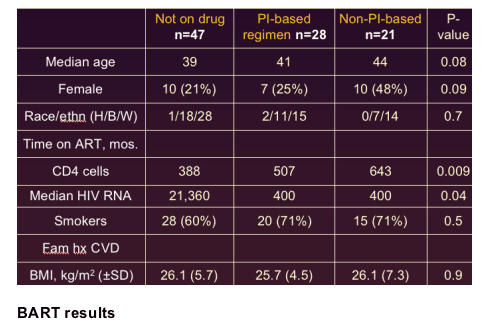
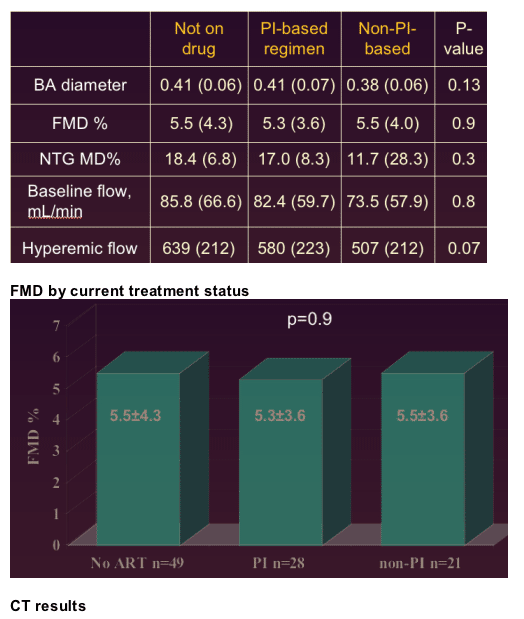
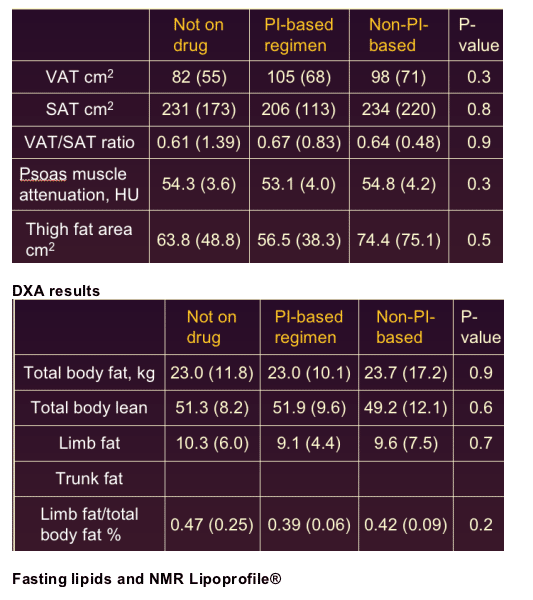
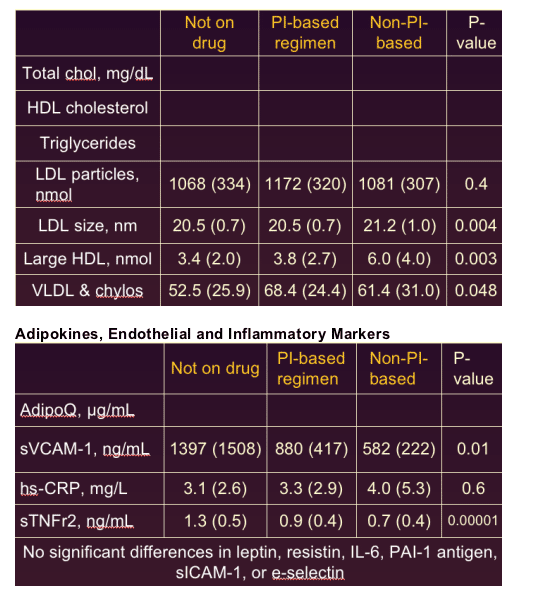
FMD by tertile of DXA limb fat %* ART-treated subjects (n=49)
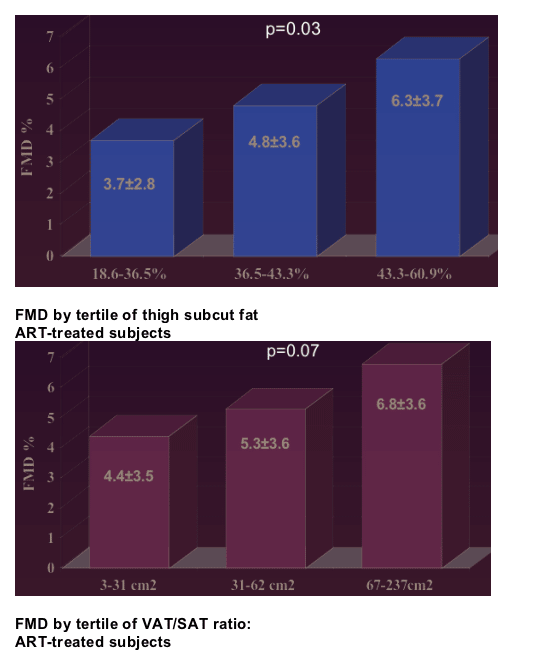
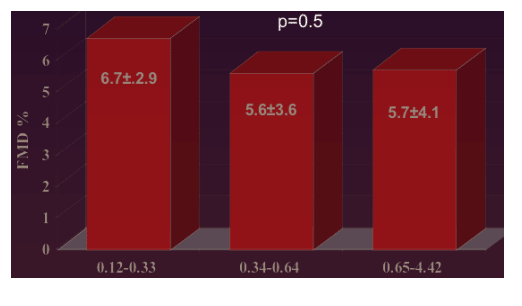
|
| |
|
 |
 |
|
|